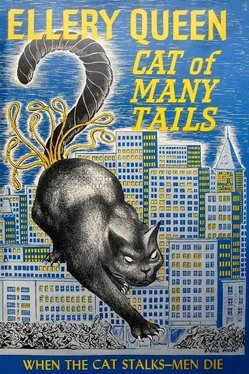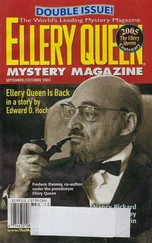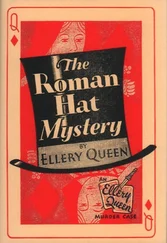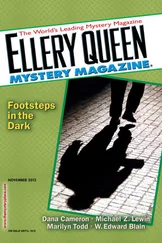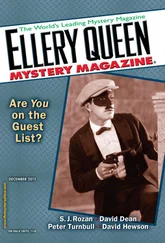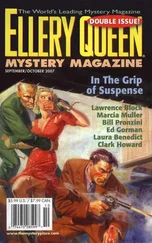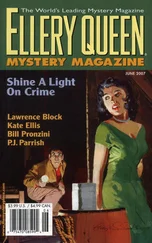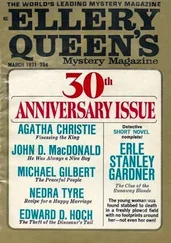“Gentlemen, our most sensible course is to treat these murders, uh, as, routine. Non-sensationally. They’re a bit off the beaten path and they present some rather tough problems, but we have the finest crime-investigating agency in the world, we’re working on the murders night and day, and the break may be expected at any time.”
“Beatrice Willikins,” said the Commissioner, “was strangled by the Cat. She was Negro. The five other victims have all been white. That’s the thing for you boys to emphasize.”
“Our angle might be, Commissioner,” said the reporter for the Harlem paper, “that the Cat is a firm democratic believer in civil rights.”
In the shout that followed, an atmosphere was created which enabled the Mayor to close “the conference without disclosing that the latest murder was giving the head of the new Cat squad a very bad time.
They were sitting around in the squad room of the main Harlem precinct weighing reports on Beatrice Willikins. The investigation on the scene, in the Park, had yielded nothing. The ground behind the boulder was rocky and if the Cat had left the print of his pads on it the first confusion following the discovery of the young woman’s body had scuffed it out. An inch-by-inch examination of the grass, soil, and paths in the vicinity of the boulder produced only two hairpins, both identified as coming from the victim’s head. Laboratory analysis of certain particles scraped from under the victim’s fingernails, at first thought to be coagulated blood or bloody tissue, proved that they consisted principally of lip rouge, of a shade popular with Negro women and which matched exactly the rouge still on the dead girl’s lips. There was no trace of the weapon with which the Cat had struck her head and the bruise gave no clue to its nature: it could only be described by that most inconclusive of terms, “blunt instrument.”
As for the catch of the police dragnet, thrown around the area within minutes of the body’s discovery, it consisted of a great many citizens of both colors and sexes and all ages, uniformly overheated, excited, frightened, and guilty-looking; none, however, gave off precisely the whiff for which Ellery’s nostrils were sniffing. It took the entire night to screen them. At the end with echoes of bedlam still in their ears, the police had only two likely fish, a white and a black, the white an unemployed jazz trumpet player 27 years old found lying on the grass smoking a marijuana cigaret, the black a skinny, undersized runner for a Lenox Avenue drop. The Negro, a middleaged man, was caught in the act of peddling the numbers. Each was stripped to the skin and thoroughly examined without result. The policy employee was released when Negro detectives rounded up witnesses who accounted for his whereabouts for an hour preceding the general crime period, and for some time after that; at which everyone, remembering the Black Ides, looked happy. The white musician was taken to Headquarters for further questioning. But, as Inspector Queen remarked, it didn’t look promising: if he was the Cat, he had been in New York on June 3, June 22, July 18, August 9, and August 19; whereas the trumpet player claimed to have left New York in May and returned only five days before. He said he had been employed during that period on a round-the-world luxury boat. He had described the boat, the captain, the purser, and other members of the ship’s orchestra; and, in some detail, several feminine passengers.
So they tackled it from the other end and hoisted the victim to the scales. Which tipped depressingly on the side of rectitude and good works.
Beatrice Willikins had been a responsible member of the Negro community, belonging to the Abyssinian Baptist Church and active in many of its groups. Born and raised in Harlem, and educated at Howard University, she had been employed by a child welfare agency and her work had been exclusively with the underprivileged and delinquent children of Harlem.
She had contributed sociological articles to Journal of Negro Education and poetry to Phylon. Occasional freelance pieces under her byline had appeared in the Amsterdam-Star News, Pittsburgh Courier, and the Atlanta Daily World.
Beatrice Willikins’s associations had been impeccable. Her friends were Negro educators, social workers, writers, and professional people. Her work had taken her from Black Bohemia to San Juan Hill; she had come in frequent contact with dope peddlers, pimps, the streetwalkers of “The Market Place”; Puerto Ricans, Negro Moslems, French Africans, Black Jews, darkskinned Mexicans and Cubans, Negroid Chinese and Japanese. But she had gone among them as a friend and healer, unresented and unmolested. The police of Harlem had known her as a quietly determined defender of juvenile delinquents.
“She was a fighter,” the precinct captain told Inspector Queen, “but she wasn’t any fanatic. I don’t know of anybody in Harlem, white or black, who didn’t respect her.”
In 1942 she had been engaged to a young Negro physician named Lawrence Caton. Dr. Caton had gone into the Army and he had been killed in Italy. Her fiancé’s death had apparently sealed off the girl’s emotional life; there was no record that she had ever gone out with another man.
The Inspector took a Negro lieutenant aside, and the detective nodded and went over to the bench on which the girl’s father was seated, beside Ellery.
“Pap, who do you figure did the girl in?”
The aged man mumbled something.
“What?”
“He says,” said Ellery, “that his name is Frederick Willikins and his father was a slave in Georgia.”
“That’s fine, that’s okay, Pap, but what man was she messing around with? White man?”
The old man stiffened. They could see him struggle with something. Finally he drew back his brown skull, like a snake, and struck.
The Negro detective stooped and wiped the old man’s spittle from his shoe.
“I guess old Pappy here figures I insulted him. On two counts.”
“It’s important.” The Inspector moved toward the bench.
“Better let me, Inspector,” said the detective. “He’s got a spitting eye.” He stooped over the old man again. “Okay, Pap, your daughter was a gal in a million. Now you want to bring down the wrath on the one who give it to her, don’t you?”
He mumbled again.
“I think he said, Lieutenant,” said Ellery, “something about the Lord providing.”
“Not in Harlem,” said the detective. “Pap, you keep your mind on this. All we want to know is, did your girl Bea know some white?”
The old man did not answer.
“It’s all this pale hide around here,” said the Negro lieutenant apologetically. “Pap, who is he? What did he look like? Bea ever tell a white skin off?”
The brown skull drew back again.
“Better save that juice,” growled the lieutenant. “Come on, Pappy, all I want is one answer to one question. Bea had a phone. Did a white man keep calling her up?”
The withered lips drew back in a tormented grin. “She has truck with a white, I kill her with my own two hands.” Then he shrank into the corner of the bench.
“Say.”
But the Inspector was shaking his head. “He’s 80 if he’s a day, Lieutenant. And look at his hands. All crippled up with arthritis. He couldn’t strangle a sick kitten,”
Ellery got up. “There’s nothing here. I need a few hours’ sleep, Dad. And so do you.”
“You go along home, Ellery. If, I get a chance I’ll stretch out on a cot upstairs. Where will you be tonight?”
“At Headquarters,” said Ellery. “With those files.”
On the morning of August 27 the Cat was at his old stand on the editorial page of the New York Extra doing a brisk business in fear. But business can be brisker, and during the day the circulation manager of the Extra earned a bonus, the reason for which became evident on the morning of the 28th. In that issue the Cat moved over to Page 1, cartoonically speaking, on a longterm lease; a new tenancy so successful that by midmorning not a copy was to be found on any newsstand in the City.
Читать дальше
